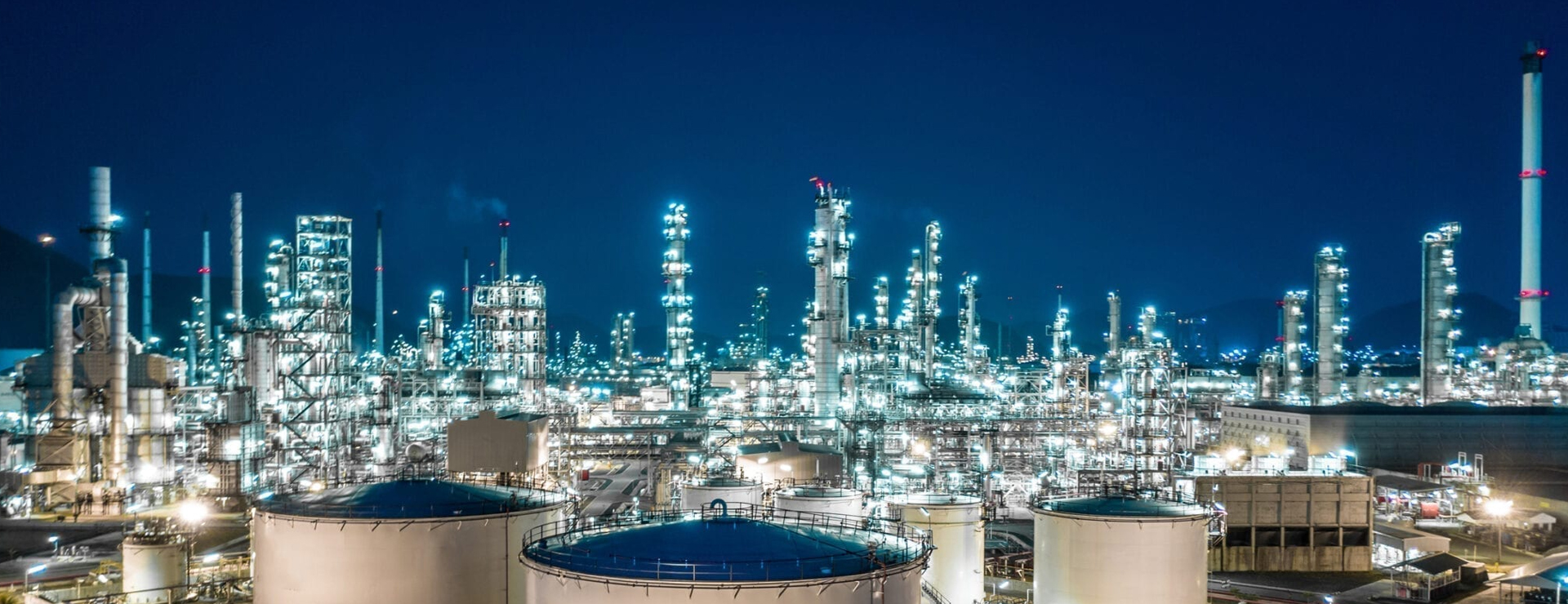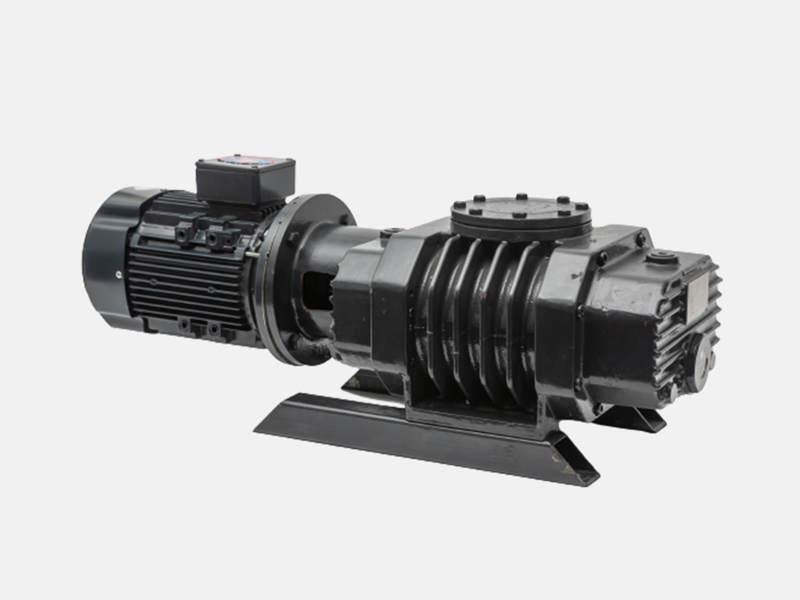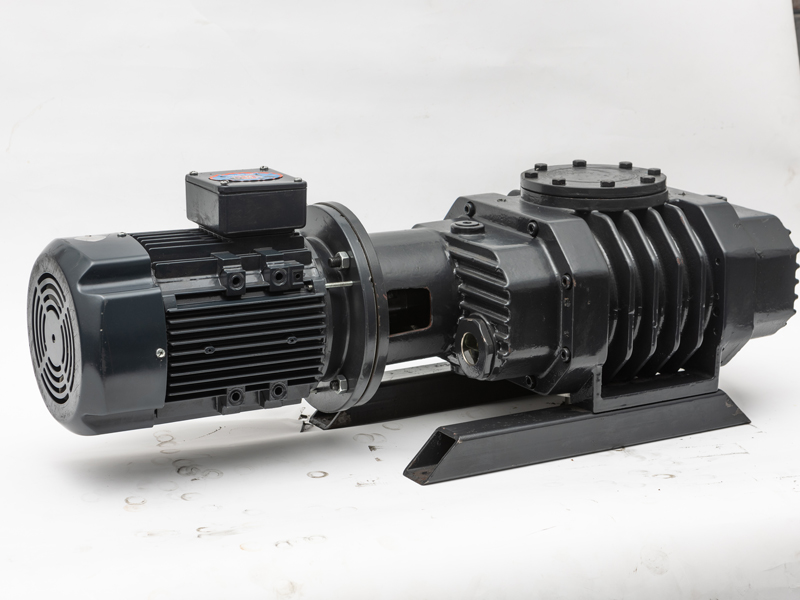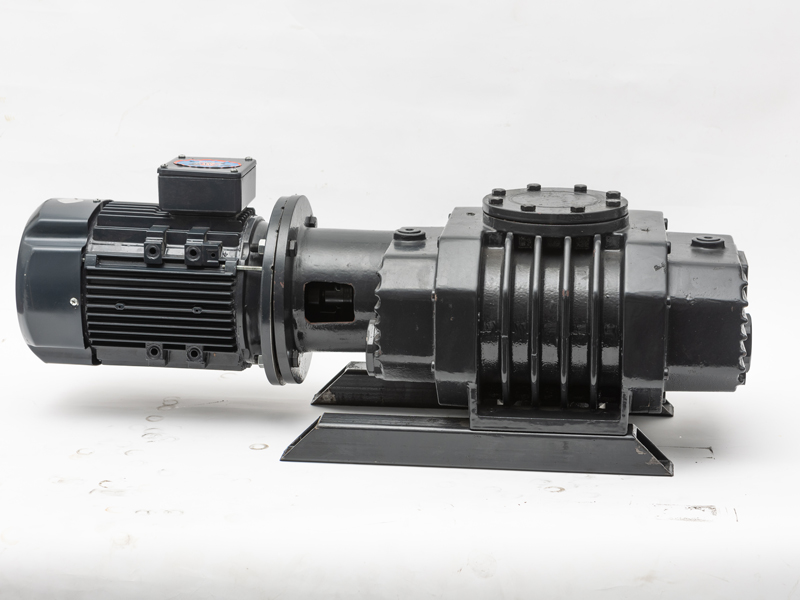Ⅱ Specifications and main technical parameters
model | pumping speedl/s | limiting pressure(Pa) | starting pressure (Pa) | Maximum differential pressure (Pa) | power (kw) | Flange diameter | Recommended use
Front stage pump model
|
partial pressure | full pressure | import | Exhaust port |
FR-250 | 70 | 5×10-2 | 0.75 | 10000 | 10000 | 1.1~1.5 | 80 | 50 | 2X-15 (或2X-8) |
FR-540 | 150 | 5×10-2 | 0.75 | 10000 | 8000 | 2.2~3 | 100 | 80 | 2X-30 (或2X-15) |
FR-300B | 300 | 5×10-2 | 0.75 | 10000 | 8000 | 4 | 160 | 100 | 2X-70 (或2X-30) |
FR-600B | 600 | 5×10-2 | 0.75 | 10000 | 5000 | 5.5~7.5 | 200 | 160 | 2X-70 |
Note: 1. The pumping rate refers to the maximum pumping rate measured by the Roots vacuum pump within the range of 0.5Pa to 10Pa under the recommended conditions of using the front stage pump.
2. Extreme pressure refers to the use of a seated compressed vacuum gauge without any container, with the pump mouth sealed, and after sufficient air extraction, under the recommended conditions of using the front stage pump
The lowest value of stable air partial pressure measured at the pump inlet, while the total pressure is measured using a thermocouple vacuum gauge.
3. Users can choose different front stage vacuum pumps according to their actual situation when using them, but different front stage vacuum pumps will make the main technology of Roots vacuum pumps
There has been a significant change in performance.
4. The execution standard of this pump is JB/T 7674-2005
4
Ⅲ
Note: 1. The pumping rate refers to the maximum pumping rate measured by the Roots vacuum pump within the range of 0.5Pa to 10Pa under the recommended conditions of using the front stage pump.
2. Extreme pressure refers to the use of a seated compressed vacuum gauge without any container, with the pump mouth sealed, and after sufficient air extraction, under the recommended conditions of using the front stage pump
The lowest value of stable air partial pressure measured at the pump inlet, while the total pressure is measured using a thermocouple vacuum gauge.
3. Users can choose different front stage vacuum pumps according to their actual situation when using them, but different front stage vacuum pumps will make the main technology of Roots vacuum pumps
There has been a significant change in performance.
4. The execution standard of this pump is JB/T 7674-2005
5
Ⅳ
Instructions for use:
1、 Preparation before startup:
1. Open the cooling water inlet valve and check if the cooling water is unobstructed.
2. When stopping the pump, the lubricating oil on the front and rear covers should be filled up to ensure that the oil level can be maintained at more than half of the position after the pump is running. The lubricating oil should be used with vacuum pump 1.
3. Corresponding measures must be taken when used in the following situations:
a) When there is dust or particles in the inhaled gas, a dust collector or filter should be installed in front of the suction port:
b) If the inhaled gas contains corrosiveness, neutralization measures must be taken:
c) If there is a small amount of water vapor in the inhaled gas and the front stage pump used is an oil sealed mechanical pump, the oil sealed mechanical pump should be equipped with a gas ballast device. When there is too much water vapor, a condenser must be installed.
2、 Start program:
1. Start the front stage pump
2. Open the valve on the pre extraction bypass pipeline of the front stage pump and the valve on the intake and exhaust pipeline of the Roots vacuum pump.
3. After the pressure in the system reaches the allowable inlet pressure of the Roots vacuum pump, close the valve on the bypass pipeline and start the Roots vacuum pump. If there is no bypass pipeline or valve, start the Roots vacuum pump after the pressure in the system reaches the allowable inlet pressure of the Roots vacuum pump. If an automatic control device is used, the starting process can be automated.
4. According to the actual situation of the vacuum system, if it is a small sealing system, the Roots vacuum pump can be started shortly after starting the front stage pump. If it is a large vacuum system, the Roots vacuum pump should be started after the front pump reaches the allowable inlet pressure of the Roots vacuum pump.
3、 Precautions during operation:
1. During operation, it is necessary to strictly follow the technical requirements of the Roots vacuum pump. Under normal circumstances, the inlet pressure of the Roots pump should be lower than 1300Pa. If the pump operates for a long time beyond the maximum allowable inlet pressure, it may also malfunction due to overheating.
2. Pay attention to the load of the motor and the temperature rise of various parts of the pump. Under normal operation, the maximum temperature rise of the pump should not exceed 40oC, and the maximum temperature should not exceed 80oC.
3. There should be no abnormal vibration or noise during operation.
4. If there is motor overload, excessive temperature rise, abnormal sound, vibration, etc. during operation, the machine should be immediately stopped to check the cause and eliminate the fault.
4、 Shutdown Procedure
1. Close the intake valve of the Roots vacuum pump.
2. Stop the Roots vacuum pump step by step, and finally stop the previous stage pump. It is strictly prohibited to make mistakes in the shutdown procedure.
3. At the same time as stopping the front stage pump, immediately inflate the air inlet of the front stage pump.
4. Close the cooling water inlet valve.
5. If it is necessary to stop using for a long time, or to prevent frost cracking in winter, the remaining water in the cooling water jackets of the front and rear covers of the pump must be drained separately.
six
V. Maintenance and upkeep
1、 Regular inspection
1. Daily inspection:
a) Oil level inspection: Too little oil can cause poor lubrication, and lubricating oil should be replenished in a timely manner.
b) Temperature inspection: Use a thermometer to check the temperature of various parts of the pump.
c) Motor load inspection: measure motor load with power meter or current meter and Voltmeter.
2. Monthly inspection:
Whether the lubricating oil has deteriorated (chemical units must increase it to weekly inspection)
Fault | Reason | Elimination method |
Extreme pressure not high | ( 1) Pipeline and system air leakage
(2) Air leakage in the pump section
(3) Limit pressure drop of the front stage pump
(4) The lubricating oil is too dirty or the brand does not match
(5) Sealing device wear | (1) System leak detection
(2) Leak detection of the pump
(3) Repair or replace the front stage pump
(4) Exchange lubricating oil
(5) Exchange
|
Insufficient pumping speed | (1) Insufficient pipeline conductivity
(2) The pumping speed of the front stage pump decreases | (1) Increase pipeline conductivity
(2) Repair or replace the front stage pump
|
motor
overload
| (1) Excessive inlet pressure
(2) Single contact between rotor end face and end cover
(3) Return oil from the front stage pump enters the pump chamber | (1) Adjust and control the inlet pressure
(2) Adjusting the rotor end clearance
(3) Device anti return oil equipment
|
superheat | (1) The selected front stage pump has insufficient pumping speed, resulting in excessive compression ratio.
(2) Excessive inlet pressure
(3) Poor cooling
(4) Gearbox lubricating oil too high
(5) Contact between rotor and pump casing
(6) Poor gear, bearings, and lubrication | (1) Re select the front stage pump
(2) Adjusting the control inlet pressure
(3) Smooth cooling water
(4) Adjusting the oil quantity
(5) Trimming
(6) Ensure appropriate oil quantity and good lubrication
|
Abnormal sound | (1) Poor assembly
(2) The deviation between the guide gear and the rotor causes the rotor to collide
(3) Excessive inlet pressure
(4) Damage to gears caused by overload or poor lubrication
(5) Bearing wear | (1) Reassembly
(2) Adjust the position to ensure clearance
(3) Adjust and control the inlet pressure
(4) Replacing gears
(5) Replacing bearings
|
Severe early wear of bearings and gears | (1) Poor lubricating oil
(2) Insufficient lubricating oil | (1) Exchange lubricating oil
(2) Replenish lubricating oil
|
8
Ⅶ Clearance List
model | Rotor to pump body | Rotor to rotor | fixed end | Expansion end |
RX-250 | 0.08~0.11 | 0.12~0.20 | 0.06~0.09 | 0.13~0.16 |
RX-540 | 0.12~0.15 | 0.14~0.22 | 0.09~0.12 | 0.15~0.18 |
RX-1000 | 0.15~0.18 | 0.18~0.26 | 0.10~0.13 | 0.20~0.24 |
RX-2000 | 0.19~0.22 | 0.24~0.32 | 0.12~0.15 | 0.24~0.28 |






 沪公网安备 31011802002620号
沪公网安备 31011802002620号